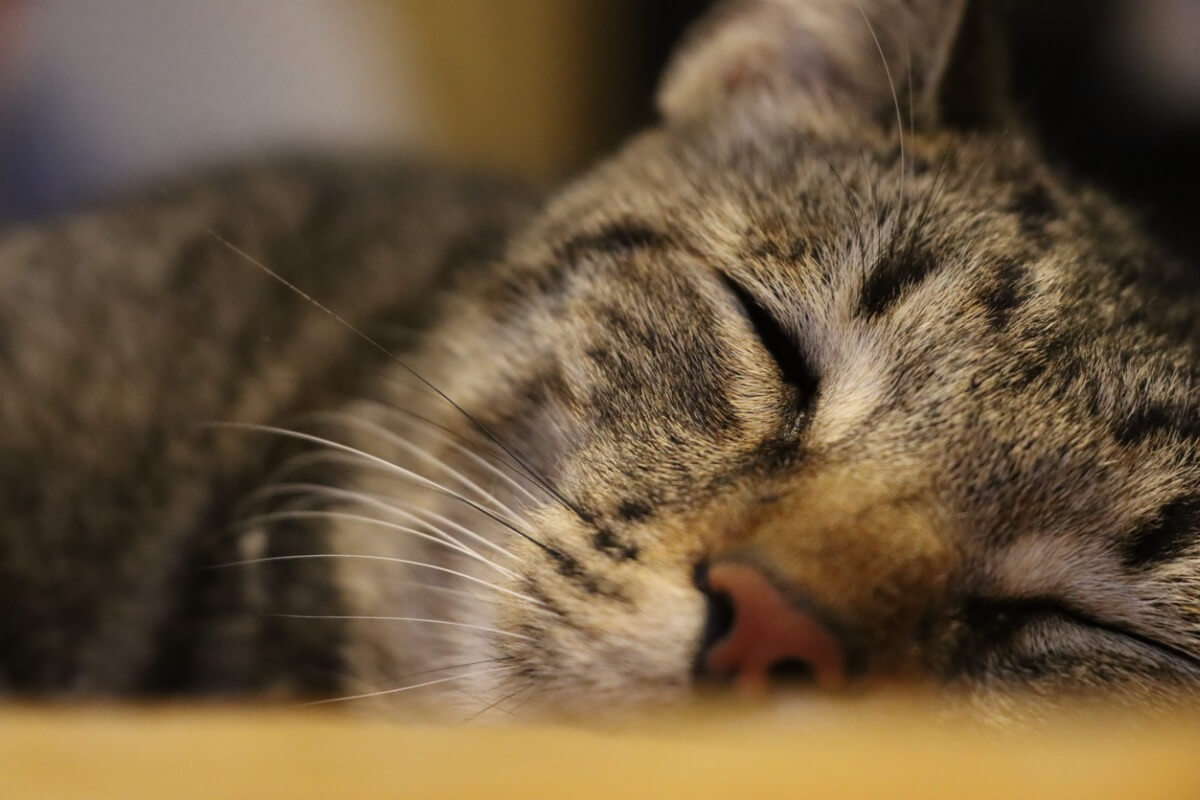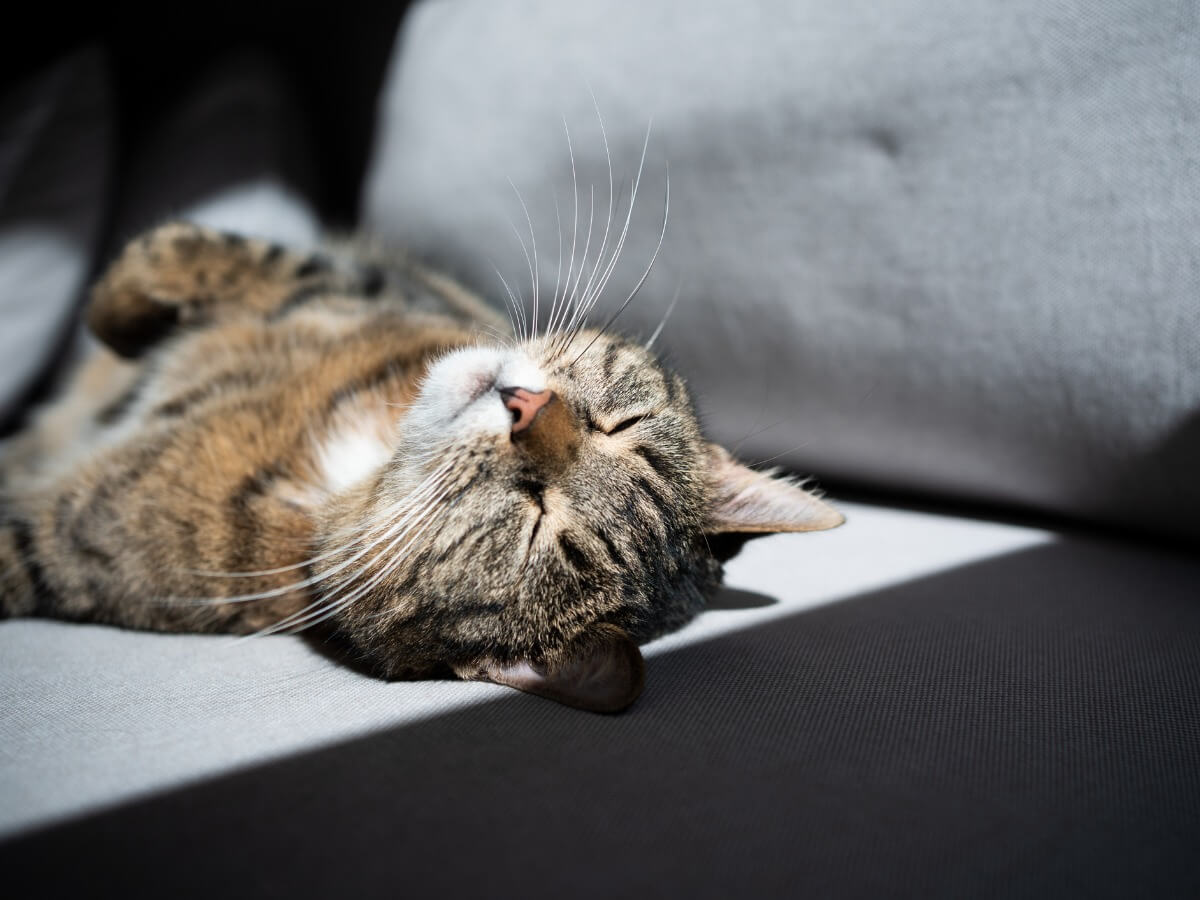How to Train a Cat to Sleep at Night

Domestic felines are nocturnal and crepuscular. Many of them spend the day taking long naps and, when the sun goes down and everyone is asleep, they become active and look for their owners. Therefore, in times of insomnia, many wonder if it’ll be possible to train a cat to sleep at night.
While it isn’t possible to change the very nature of these felines, you can get them to leave their humans alone while they rest. If you’re finding it difficult to get a good night’s sleep because of your cat meowing and hunting your feet under the blankets, then this article is for you.
Adaptations of cats to nightlife
Cats have a circadian rhythm that’s totally opposite to a human’s, which means that heir secretion of corticosteroids occurs during the night. In contrast, the release of melatonin (responsible for the regulation of sleep) is triggered by sunlight, causing drowsiness in the animal. This is something that’s impossible to change, because it’s the normal functioning of the feline body.
This sleep-wake rhythm isn’t the only thing that differs from daytime animals, as the cat has other adaptations to live in the dark. Here are the most important ones:
- Vision in dim light: The cat is able to see in low light conditions. This is because its eye has more rods (the cells that collect light from the environment) and a membrane called tapetum lucidum, which acts as a mirror to “recycle” the light that escapes from the eye.
- Good hearing: When hunting in the dark, they can’t depend on their sense of sight to catch prey. Cats are able to hear even the slightest sound, as their auditory system picks up to 50,000 Hertz in frequency. To give you an idea of how good it is, human hearing is only 20,000 Hertz.
- Silent footsteps: I’m sure you’ve never heard a cat’s footsteps. This is thanks to the pads they have on their paws and the way they move, as they tread softly so as not to make any noise when approaching their prey.
As you can see, daytime life isn’t made for felines, as there’s too much light and too much noise in the most active hours of the day. However, in the following sections, we’ll bring you some useful tips to help your cat amuse itself while you sleep.

How to train a cat to sleep at night
Most of the nocturnal calls for attention from your domestic feline are due to a lack of entertainment and hunger. There’s no magic recipe or switch that will allow a cat to sleep at night, but you can follow the steps below.
Play with your cat during the day
The best way to help your feline get some sleep at night is to tire them out during the day. Whenever you can, play with them, as this will give them exercise, expend energy, and strengthen your bond. And, of course, it goes without saying that you’ll have a great time together too!.
Fishing rod type toys are ideal, as they allow the feline to jump and hunt with intensity without hurting you unintentionally.
Even if you have a great time playing with your cat, remember to respect its rest periods. Cats sleep 12 to 16 hours a day in intermittent naps and depriving them of sleep isn’t an ethical way to get them active during the day.
Basic conditioning
An essential part of getting a good night’s sleep will be to disassociate your room from play and food, as these are the two main reasons cats come to their owners during the night. To do this, you can take several steps:
- Close the door before going to sleep: You may have to put up with a lot of meowing and tantrums until your cat gets used to the new situation, but be patient.
- Don’t reinforce their calls for attention: Whenever you respond to their games or requests for food, you encourage them to come to you at night.
- Don’t associate your room with their needs: Take games, food bowls, sandboxes and anything else that has to do with your feline out of the room. Until it gets used to the new routine, don’t respond to their calls for attention when it comes looking for you in your room.
In this way, and little by little, the cat will learn that there are areas where you rest and need peace and quiet. This conditioning is easy to achieve if your home is calm and mutually respectful.
Nighttime enrichment
Another way to train a cat to sleep at night is to provide sufficient entertainment during this period. This way, even if they don’t sleep, they won’t need you to keep them active. Here are a few tips:
- Place a platform at the window: A shelf, a cat hammock, or any surface that allows them to look through the glass will do. The street is an inexhaustible source of stimuli that will keep your cat occupied.
- Leave toys around the house: If you have them within reach, your cat can play whenever they want and won’t need to look for you to amuse itself.
- If your cat needs regular meals, always keep their bowl full: If they have a special diet, you can choose to put their bowl out before going to bed so that they don’t get hungry during the night.
- Hide treats and food around the house: Foraging is one of the activities that consumes the most energy resources in animals.

As you can see, training a cat to sleep at night isn’t healthy for them and isn’t even something that can be changed naturally. That’s why we’re calling for responsible ownership and awareness. It’s possible to take an animal into your home and live with it in an ethical way, even if it secretes melatonin during the day and is active at night.
All cited sources were thoroughly reviewed by our team to ensure their quality, reliability, currency, and validity. The bibliography of this article was considered reliable and of academic or scientific accuracy.
- Sarah Zielinski, The Secret Lives of Feral Cats, Free-roaming, unowned kitties live differently from our beloved pets, SMITHSONIAN – Disponible en: https://www.smithsonianmag.com/science-nature/the-secret-lives-of-feral-cats-179790776/
- Lesiuk, T. P., & Braekevelt, C. R. (1983). Fine structure of the canine tapetum lucidum. Journal of anatomy, 136(Pt 1), 157.
- LEYVA, H., ADDIEGO, L., & STABENFELDT, G. (1984). The effect of different photoperiods on plasma concentrations of melatonin, prolactin, and cortisol in the domestic cat. Endocrinology, 115(5), 1729-1736.
This text is provided for informational purposes only and does not replace consultation with a professional. If in doubt, consult your specialist.